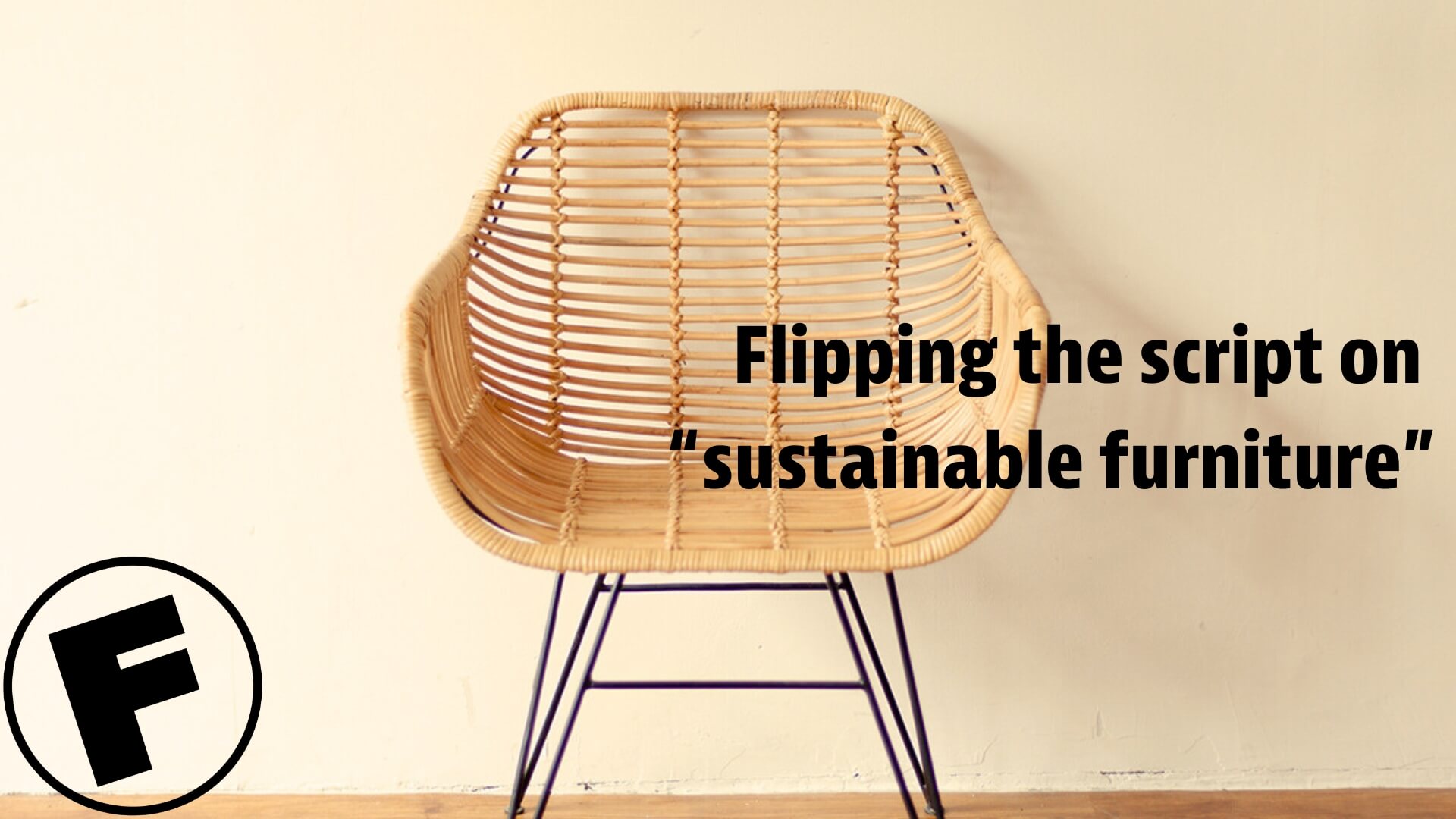The Most Eco-friendly Furniture Materials (And How Restoration Changes the Sustainability Game)
In today’s eco-conscious world, there’s a constantly growing demand for goods made from sustainable materials—and furniture products are a major consideration.
The most sustainable furniture materials reduce environmental impact, but they also ensure longevity and durability, making them a wise investment for any homeowner or business. Let’s take a look at some popular materials—and surprise you with what the most renewable resources actually are!

What makes certain materials “eco-friendly”?
The quintessential question.
Is any organic material sustainable? Is it more about the source and/or process for obtaining said materials? Should we commit ourselves to believing that only biodegradable materials are environmentally responsible?
It’s all very subjective.
In general, sustainable materials are typically: renewable, non-toxic, durable, and require minimal maintenance.
“In general, sustainable materials are typically: renewable, non-toxic, durable, and require minimal maintenance.”
Furniture manufacturers would certainly have you believe that their ways are best. With FSC (Forest Stewardship Council) labels and marketing claims to convey it, furniture companies will tirelessly demonstrate that their products are the best for the environment.
There’s nothing wrong with this, of course, as the sustainable furniture materials those companies use— and which we’ll soon examine—are certainly a step in the right direction for Earth-friendliness. But it’s become second nature for people everywhere to assume any synthetic material—or other resource that takes energy to produce—is automatically bad.
Well, there’s a curve ball here.
Let’s start by looking at some of the more popular eco-friendly materials, then get into how Fibrenew is redefining what “sustainable furniture” actually means. Read on!
Common (and uncommon) sustainable furniture materials
These materials generally have minimal negative impact on the environment throughout their lifecycle, from production to disposal.
The choice of materials for sustainable furniture can vary depending on factors such as the availability of resources, local environmental conditions, and the specific design and function of the piece of furniture.
However, here are some of the most commonly (and, honestly, uncommonly, too) used sustainable materials for making furniture:
- Wood from sustainable sources: Sustainable wood is a classic material for furniture, but it should be sourced from sustainably managed forests or reclaimed wood to ensure responsible harvesting practices. Look for certifications to verify sustainable sourcing.
- Bamboo: Bamboo is a fast-growing grass that can be harvested in a sustainable manner. It’s strong, lightweight, and can be used for various types of furniture.
- Recycled and reclaimed wood: Using wood from old buildings, pallets, or discarded furniture can reduce the demand for new resources and help minimize waste.
- Recycled metal: Metal furniture made from recycled materials like aluminum or steel reduces the need for virgin resources and energy-intensive production.
- Recycled plastic: Furniture made from recycled plastic is durable and helps divert plastic waste from landfills and oceans.
- Cork: Cork is a renewable material harvested from the bark of cork oak trees. It’s often used for tabletops, flooring, and upholstery due to its durability and natural properties.
- Upcycled and repurposed materials: Creatively repurposing old or discarded materials can result in unique and sustainable furniture pieces.
- Natural fibers: Natural fibers such as jute, hemp, and organic cotton can be used for upholstery and cushioning in sustainable furniture.
- Low VOC (volatile organic compounds) finishes: Choosing finishes and coatings with low or no VOCs helps reduce indoor air pollution.
- Glass: Glass furniture can be sustainable if made from recycled glass, and it’s a durable and recyclable material.
- Rattan and wicker: These natural materials are often used for outdoor furniture and are renewable if harvested responsibly.
- Mushroom leather (mycelium meather): Yes, you read that right. Mycelium-based leather alternatives are being explored as sustainable, cruelty-free alternatives to animal leather.
- Natural finishes: Using natural finishes like beeswax, linseed oil, or shellac instead of synthetic varnishes can reduce the environmental impact of furniture production.
Sustainable furniture is not just about the materials used but also about the manufacturing process, energy efficiency, durability, and end-of-life considerations (recyclability or biodegradability).
That’s why the leathers, plastics, and vinyls of the world tend to get a bad rep. But here’s where Fibrenew comes to the rescue.
Flipping the script on what “sustainable furniture” is
In our fast-paced, consumer-driven society, the concept of “use and throw away” has become commonplace.
However, the environmental implications of such a mindset are staggering.
On the brighter side, the sustainability movement emphasizes repairing and reusing items to counter this trend. Leather, plastic, and vinyl—Fibrenew’s bread and butter—are three materials that greatly benefit from a repair-and-reuse approach.
The circular economy and repair culture
The idea of a circular economy revolves around creating a closed-loop system where items are used, repaired, and reused instead of being discarded. Leather, plastic, and vinyl products fit perfectly into this concept.
By prioritizing repair over replacement, we not only save money but also conserve resources, energy, and reduce waste.
Moreover, fostering a repair culture challenges the planned obsolescence of many modern products. It encourages manufacturers to design for longevity and supports businesses that specialize in repair and refurbishment.
1. Leather: Natural and long-lasting
Leather is a byproduct of the meat industry, and it’s both durable and versatile.
- Repair Benefits: When leather items, like sofas, jackets, shoes, or anything else show signs of wear or damage, they can often be restored. Repairing scuffs, scratches, or tears ensures the item’s longevity and reduces the need to purchase a replacement.
- Environmental Impact: Leather takes a significant amount of energy and resources to produce. By repairing and reusing, we maximize the utility of those resources and reduce the need for further production.
2. Plastic: Ubiquitous but controversial
Plastic is everywhere. While its resilience and versatility make it popular, it also poses significant environmental challenges due to its slow decomposition rate.
- Repair Benefits: Plastic items, from toys to storage containers, can often be mended when broken. This extends their lifespan and defers their journey to the landfill.
- Environmental Impact: The production of new plastic items requires raw materials and energy. Moreover, plastic waste often ends up in oceans, endangering marine life. By repairing plastic goods, we limit the demand for new items and reduce environmental contamination.
3. Vinyl: Durable and multi-purpose
Vinyl is a type of plastic known for its durability, and it’s commonly used in items like records, upholstery, and flooring.
- Repair Benefits: Vinyl products, especially in upholstery, can develop rips or tears. Instead of discarding these items, they can be patched up, ensuring many more years of use.
- Environmental Impact: Like plastic, vinyl production has a considerable carbon footprint. Repairing vinyl items decreases the demand for new production, thereby reducing the associated environmental impacts.
Fibrenew champions restoration, repair, and reuse always
The repair and reuse of leather, plastic, and vinyl products offer a sustainable path forward in our consumption habits.
As consumers, embracing this mindset not only benefits our wallets but also plays a crucial role in safeguarding our planet for future generations.
And speaking of generations, the time is now for people young and old to get real about sustainability and their futures. Owning your very own Fibrenew business is just the ticket to building your dream while also doing your part for the future of our planet.
Get in touch today and let’s chat—and remember, to mend is more sustainable than to end!








